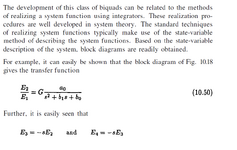houly75
Newbie level 4

- Joined
- Dec 23, 2009
- Messages
- 6
- Helped
- 0
- Reputation
- 0
- Reaction score
- 0
- Trophy points
- 1,281
- Location
- Paris
- Activity points
- 1,358
Hello,
I'm looking for a method that permits to "convert" Laplace transfer function of a biquad filter to a block diagram (in order to transform into a schematic). I read a few books about this subject (filters) but all of them give a partial answer and not a description of the method used. For example this is an extract of "ANALOG FILTER 2sd edition" (Kendall Su)


Do you know a reference book which permits to help me to better understand the method ?
I'm looking for a method that permits to "convert" Laplace transfer function of a biquad filter to a block diagram (in order to transform into a schematic). I read a few books about this subject (filters) but all of them give a partial answer and not a description of the method used. For example this is an extract of "ANALOG FILTER 2sd edition" (Kendall Su)
Do you know a reference book which permits to help me to better understand the method ?


